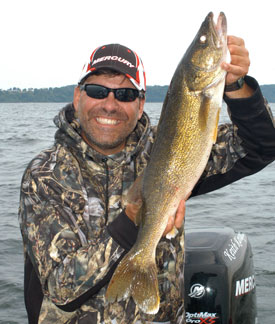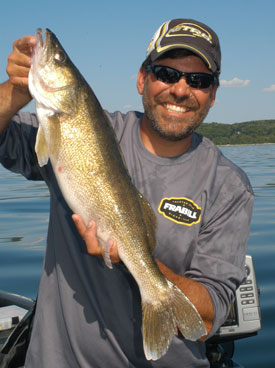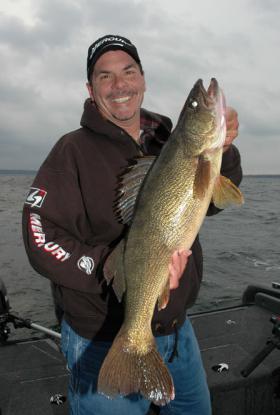
Unless you’ve been hiding under a rock someplace the past couple of years, you probably already know that one of the hottest techniques in walleye fishing these days is trolling structure with crankbaits on lead core line – also known as Contour Trolling. If the Forum threads on The Next Bite and other websites are any indication, it’s been one of the most asked about and widely discussed topics among anglers. Even with all the interest and coverage however, it’s still a very misunderstood presentation. Those that try it and “get it” sing its praises of versatility and effectiveness. But there are still plenty of anglers that have tried it and failed miserably to score mainly because they haven’t yet grasp the nuances of the technique. Let’s try to remedy that here and now.
Lead core line, for those of you not that familiar with it, is basically Dacron line with lead running through the center of it. The outside sleeve of Dacron is color coded every thirty feet, which is very helpful in setting out lines and determining how much lead core to use for particular applications. The way the line is constructed gives lead core a great deal of sensitivity because it has virtually no stretch. The most common size used in walleye trolling is 18# test. All the weights higher than 18# have the same size of lead insert, but sport heavier Dacron coatings. Therefore, 18# has the thinnest diameter for the amount of lead used. A key advantage to this is that you can get more of it spooled on a reel, another is that it sinks the best with the least amount of drag. This stuff is bulky by nature, and we recommend using large capacity, line-counter trolling reels like the Bass Pro Shop’s StrataMaxx STMX-30 for your lead core set-ups.
The first thing an angler must realize about contour trolling lead core is that this is a technique that involves getting the lures down near the bottom, and following the breaks to contact fish relating to that structure. If the lures aren’t running just off the bottom, then chances are they’re going to go untouched. Of course, that is somewhat dependant on “visibility”. If the water is very clear, then the baits can be running as much as two or even three feet off the bottom and the walleyes will still swim up to smack them. But, many times you could be dealing with dingy, stained water and your offering had better be no more than six inches to a foot off the bottom if you’re hoping to get bit. There are even rare occasions that getting that lure to bang along the bottom is what will trigger the most bites.
 Placing a crankbait in such a precise depth zone doesn’t sound like such a tough task to most walleye anglers familiar with conventional trolling tactics. Many veteran trollers have long since learned how to dial in their favorite cranks to very precise depths with such tricks as varying line diameter, amount of line let out and adding weighting systems like Off Shore Tackle Snap Weights and in-line sinkers. That’s fine if you’re trolling over a relatively large flat piece of structure or over open water for suspended walleyes, but we’re talking contour trolling here. This is a technique where the depth changes quickly and often, and trying to reel in line or let out line to keep baits in the proper depth can quickly become way more like work than a day of fishing was ever meant to be.
Placing a crankbait in such a precise depth zone doesn’t sound like such a tough task to most walleye anglers familiar with conventional trolling tactics. Many veteran trollers have long since learned how to dial in their favorite cranks to very precise depths with such tricks as varying line diameter, amount of line let out and adding weighting systems like Off Shore Tackle Snap Weights and in-line sinkers. That’s fine if you’re trolling over a relatively large flat piece of structure or over open water for suspended walleyes, but we’re talking contour trolling here. This is a technique where the depth changes quickly and often, and trying to reel in line or let out line to keep baits in the proper depth can quickly become way more like work than a day of fishing was ever meant to be.
That’s where the lead core line shines. Lead core is very “speed affected”. Because of the line’s bulk, water resistance effects how it runs in the water, so if you kick up your trolling speed a notch, the lead core gets pushed up and runs shallower. On the other hand, if you slow down, the weight of the lead core enables it to drop down and run deeper. Finding the right amount of lead core to let out to get your lure to the right depth at your average speed however is always the part of the puzzle that frustrates a lot of anglers right from the start.
Remember, lead core has little stretch and therefore is very sensitive. That makes this style of trolling very much a game of “feel”, not unlike jigging for walleyes. When jigging, you know it’s important that you maintain feel of your jig at all times so that you know when the jig is in contact with the bottom, and so you can feel the bite. With lead core the “feel” is also key because the best way to determine the depth you are running your baits to start with is to set an average trolling speed (about two mph), and begin letting out line until you begin to feel your lure ticking the bottom. Once you know the lure is hitting bottom, reel up line a couple of feet at a time until you no longer feel the lure hitting bottom. Your bait is now just off the bottom and in the fish zone. To help you get started, a good rule-of-thumb goes like this: At an average trolling speed (2 mph) the lure you’re running will dive the depth its deigned to run with 15 feet of line out (the length of the leader) plus five feet for each color of lead core. Still, getting the lure down there and “ticking” bottom is the fool-proof method for knowing you’re in the zone.
 The leader material you choose to run from the lead core to your lure also plays a key role in the amount of feel your set up will have. Most of the time we’ll tie on a 15 foot leader of 10/4 FireLine or 10# test Trilene XT for contour trolling. The shorter leader keeps the knot out of the guides when reeling in a fish and it also allows the lure to react quicker to depth changes. The leader choice is a very important factor to consider. In situations where we’re fishing a “dirty” bottom, one littered with leaves, wood and other debris, we’ll opt for the FireLine because it makes the entire system, from reel to lure, no-stretch and very sensitive. By running a set-up like this, it is very easy to monitor how the bait’s are running by watching the rod tips as you troll. The vibration put out by the lure’s action is telegraphed up the line to the rod tip, causing it to vibrate. If the lure happens to pick up a leaf or other piece of gunk (which is a frequent problem when trolling near the bottom), its action will be deadened, and the rod tip will quit vibrating. That tells you to reel in the lure, clean off the debris, and get back to fishing. On the other hand, if the bottom where you’re fishing is relatively clean and snags are not much of a concern, that’s when a leader of monofilament like Trilene XT is preferred. Since all that lead core is no-stretch, the mono leader gives the system a nice built-in shock absorber which can come in handy when fighting in big fish.
The leader material you choose to run from the lead core to your lure also plays a key role in the amount of feel your set up will have. Most of the time we’ll tie on a 15 foot leader of 10/4 FireLine or 10# test Trilene XT for contour trolling. The shorter leader keeps the knot out of the guides when reeling in a fish and it also allows the lure to react quicker to depth changes. The leader choice is a very important factor to consider. In situations where we’re fishing a “dirty” bottom, one littered with leaves, wood and other debris, we’ll opt for the FireLine because it makes the entire system, from reel to lure, no-stretch and very sensitive. By running a set-up like this, it is very easy to monitor how the bait’s are running by watching the rod tips as you troll. The vibration put out by the lure’s action is telegraphed up the line to the rod tip, causing it to vibrate. If the lure happens to pick up a leaf or other piece of gunk (which is a frequent problem when trolling near the bottom), its action will be deadened, and the rod tip will quit vibrating. That tells you to reel in the lure, clean off the debris, and get back to fishing. On the other hand, if the bottom where you’re fishing is relatively clean and snags are not much of a concern, that’s when a leader of monofilament like Trilene XT is preferred. Since all that lead core is no-stretch, the mono leader gives the system a nice built-in shock absorber which can come in handy when fighting in big fish.
We’ve already said that lead core will rise up as you speed up and drop down as you slow down, but again it becomes a game of “feel”. Learning to “feel” your speed changes simply takes time and practice. It’s just a matter of getting the hang of speeding up and slowing down just enough to get your lures to follow the contour as you troll. Changes in trolling speed shouldn’t be drastic. In fact it’s amazing just how a subtle change in speed on the kicker motor will affect the lure’s running depth. Once you get the hang of it, you’ll be walking those baits up and down break-lines like the masters.
We know getting set up and learning the ins and outs of lead core trolling can be daunting. Many of you have already invested in the extra tackle and gear it takes to run lead core, only to realize the learning curve can be a long one. But if you’re looking for a versatile tactic that will pick off walleyes relating to structure the way no other presentation can, you owe it to yourself to get out there and contour troll lead core a few more times … this time with feeling!










